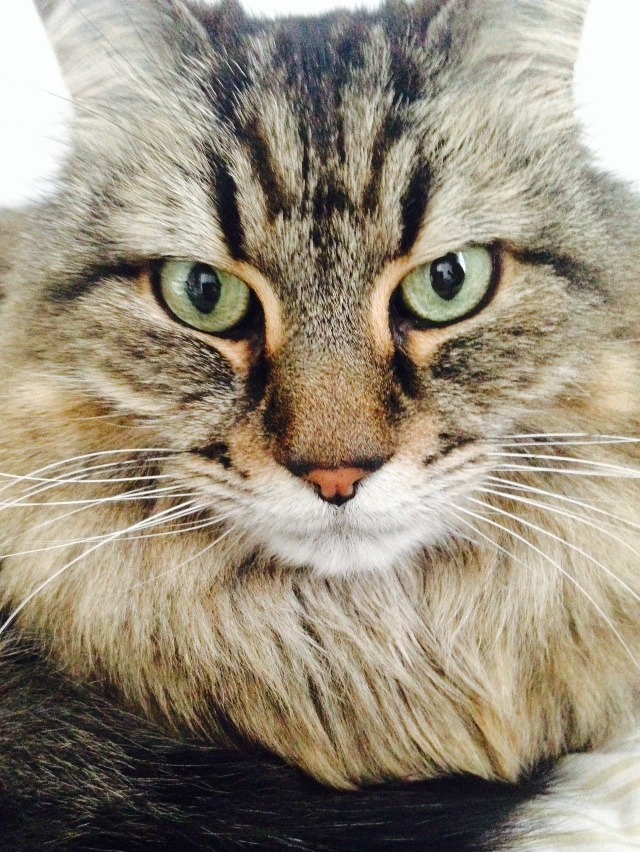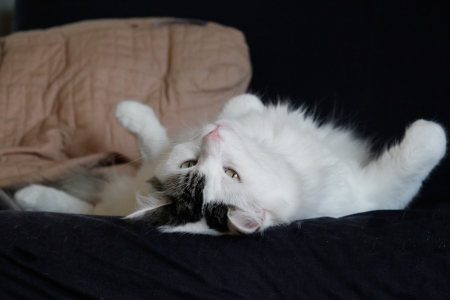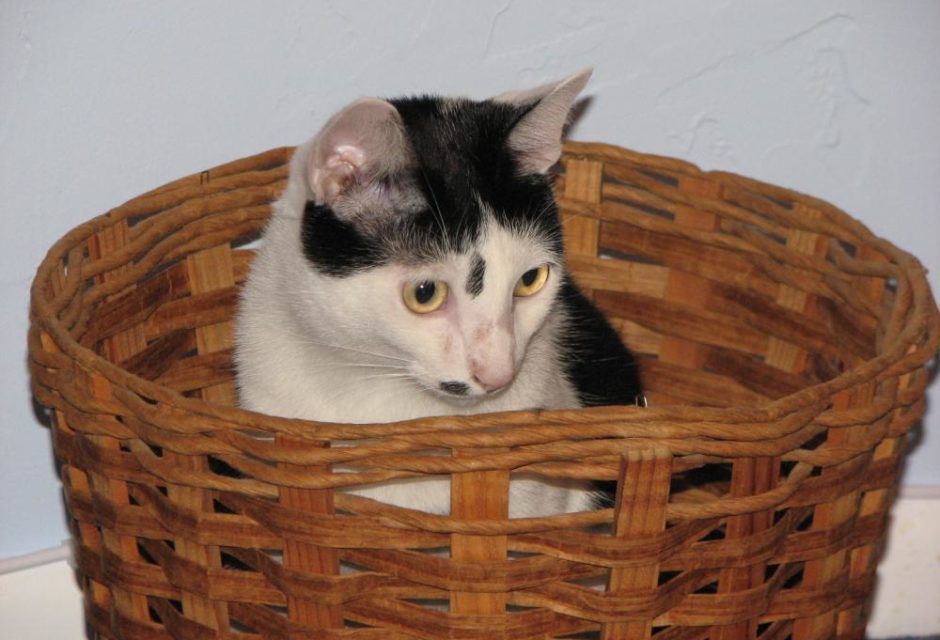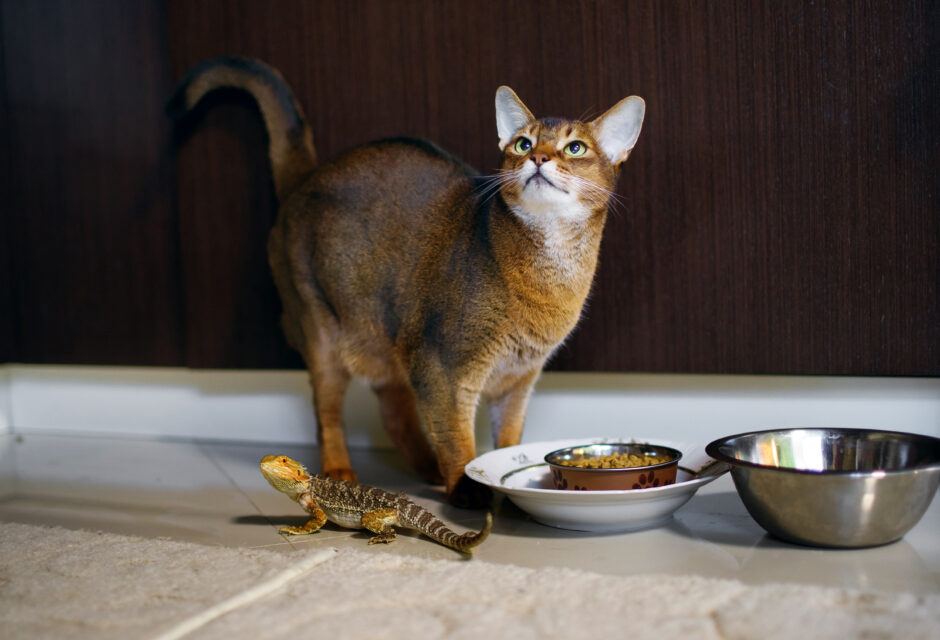

Tricks You Can Train Your Cat To Do
How trick training can strengthen the bond between you and your cat
Tricks? A cat? That’s a dog thing, right? Wrong! Though not known for performing on cue, cats are just as capable of learning new behaviours as dogs. The difference is in motivation and drive. Dogs are more sociable and, as such, can learn new behaviours within a group construct. They’ll learn a trick to please you, for a treat, or both. Cats, though, have a more egotistical approach. Basically, it’s “what’s in it for me?” That almost always means food. If you want to teach tricks to your cat, the right bribe at the right time is the magic ticket.
Why Train a Cat? Good question. Most cat lovers enjoy their cats for who they are and what they do on their own. Their independent nature is one of the reasons we love them, right?
“Training a cat offers great rewards for both you and your cat,” says Anne Gordon, veteran Hollywood animal trainer. “It creates a more powerful bond that will help you understand each other on a higher level.” Gordon adds that it is also an effective way to communicate beyond what you might have thought possible. “And,” she adds, “it’s just fun.”
Truth is, you have probably trained your cat without even knowing it. Example: At feeding time, you pull out a can of cat food and tap on it with a spoon. Out of nowhere, your feline comes running. Why? Because they have been conditioned to know that the tapping sound is always followed by food.
Other reasons to train? Simple: as Gordon says, training your cat will strengthen the bond between you. And it will actually make your cat smarter. By expanding your cat’s vocabulary and repertoire of behaviours, you literally create more neural connections in her brain. As in humans, a bigger vocabulary makes for a stronger brain. Who doesn’t want a smarter cat?
“Training your cat will strengthen the bond between you and actually make your cat smarter.”
Getting Started A key factor in teaching tricks to a cat is—you guessed it—the cat. Yours needs to be fairly outgoing with a good appetite. Timid cats or feral rescues won’t respond
as well as a young, frisky, friendly one. Shorthaired cats such as the Siamese, American Shorthair, or Burmese tend to be more outgoing than longhaired breeds like the Persian or the Angora, though any breed or mixed breed can learn if trained properly from a young age. Older cats learn more slowly, as will those with a weak food drive.
Feed Me on a Schedule! Food is the primary motivator in shaping a cat’s behaviour. If your cat loves dinnertime, you won’t have much problem motivating them. To optimize
training though, you’ll want to establish precise feeding times instead of free feeding. If food is always available, it will mean less than if it is anticipated at a specific time. Exact feeding times of short duration will program your cat to be hungry when you need her to be.
The best treats to use? Instead of using a typical cat treat, try a lickable cat treat! This allows you to better control the delivery of the treat and keeps your cat there, licking. Other treats can take too long to eat or cause the cat to walk off to a corner to eat it.
In addition to a lickable treat, you can use meat-flavoured baby food on a spoon, tiny bits of meat, tuna, or cheese. Use whatever works, provided it can be eaten quickly.
A cat that will not respond to treats will be challenging to teach. But if there is something your cat does respond favourably to—a particular toy, a catnip ball, or even a teaser wand—try using it instead of food.
Equipment A clicker is a key training device for cat training. The “click” sound acts as a bridge between the desired behaviour and the reward. The instant your cat performs a desired behaviour, you “click” then reward. The click is the signal to the cat that it has done the right thing and that a treat is coming. It will heighten your cat’s expectations and attention.
Another prop you might want to obtain is a light leash in combination with a light cat harness. If you have a kitten or very young, outgoing cat, walking on a leash can be a good way of safely getting your pet outside.

chrisbrignell/Shutterstock
Set the Stage Schedule training sessions right before feeding time. That way, your cat will be properly motivated. Make the sessions brief—no longer than a few minutes. Choose a quiet room with no distractions, including people or other pets. Consider using a tabletop, desk, or coffee table for the training sessions. Cats like to be up high, and it will be easier on your back!
Familiarize to Touch Training frequently involves touching your cat, so preface training with touch desensitization. Hopefully you have done this since kittenhood! Brushing, massaging, and even trimming nails will help immensely. While you lightly brush, offer a nice treat. Same goes for massage.
Pick your cat up from an early age. Pick up, treat, repeat. Eventually, carry your cat about the house, then put her down and treat. If your cat simply does not like it, it’s okay, but it means that trick training will take a bit longer.
EDITOR’S PICK

Have them eating out of your hand! Churu, the signature wet treat from Inaba, is a perfect choice for trick training. These lickable purée meat tubes for cats were designed to be fed by hand for an interactive way to spend time with your cat.
Made with wholesome ingredients and no bad stuff (you won’t find grains, preservatives, artificial colors, or carrageenan), these hydrating, creamy treats come in 19 savory flavours and are only six calories a tube! (from $4, inabafoods.com)
4 Tricks to Teach Your Cat
#1. SIT
First, be sure your cat is hungry! Place her atop a table in a standing position in front of you. Hold a treat an inch or two in front of her nose. A lickable treat like Churu or a spoon with baby food works well because you can control access to the treat. When your cat shows interest, slowly move the treat up and back while saying her name and “sit.” Keep the treat close enough so that your cat doesn’t try to rise up to get it. You should get her to naturally sit within ten tries. If not, end the session and try later.
The moment she does sit, click your clicker, give her the treat, and say, “good sit!” Repeat once more, then quit. Right before the next mealtime, repeat the process. Within a few weeks, she should understand the behaviour and sit for you on command.
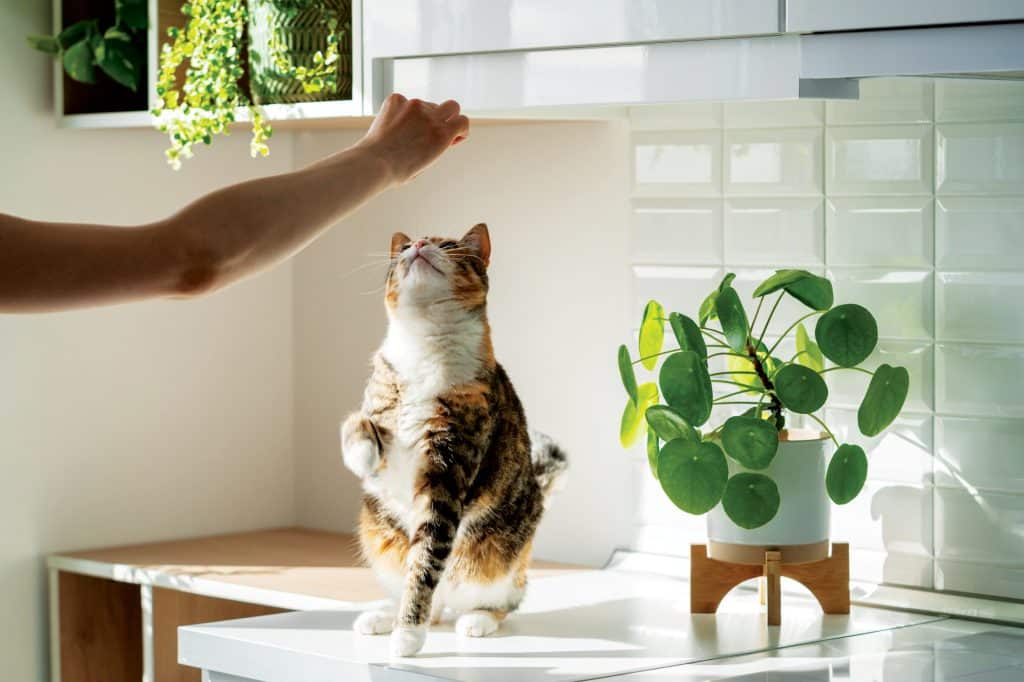
DimaBerlin/Bigstock
#2. SPIN
Start the trick with your hungry cat standing on the floor (not a table), with you kneeling in front of her. With a treat in one hand and a clicker in the other, hold the treat near your cat’s nose, then slowly lure her in a small circle while saying “spin.” How you offer and move the treat (or spoon) will be a trial-and-error affair, so work it until you perfect it for your particular cat. If she follows the treat around even partially, click and reward. Success will be when you get her to go full circle. Do not overwork it, as the cat will get bored.
Each day, slowly increase the speed of the spin and the distance your treat hand is from her nose. Take your time and reward any positive movement. The circular motion you make with your treat hand will eventually become the hand sign for the trick. The goal is to get your cat to spin without luring her all the way around. When perfected, just a small circular hand motion from three or four feet away coupled with the spoken command will trigger the spin. Be sure to click and treat each time!
#3. SHAKE
Though not necessarily a hard trick to teach, some cats are not crazy about having their feet touched, so don’t overdo it. Start with her sitting on the edge of a table. Have a treat in your hand. Gently tap on the back of your cat’s wrist while saying “shake” until she lifts the foot. Even a slight lift should be clicked and rewarded!
Work this briefly, five times each day. Each time, use less and less physical manipulation on the foot until all you need to do is reach your hand out and say “shake” to initiate the lift.
Once she really gets it, you can try getting her to raise the other paw, using the same process of tapping on the back of her wrist.
#4. KISS
Hope you don’t mind getting a friend’s face messy! Teaching your cat to kiss your cheek will require you to dab a bit of tasty food on a friend’s cheek. You can’t use yourself for this until your cat has been taught this trick.
Use a treat that will stay on your friend’s face. Meat-flavored baby food or cream cheese will work. To begin, place your hungry cat on a table with your friend in a chair in front of her. Be sure your friend already has the treat smeared on a cheek and that it is clearly evident to the cat. Get your friend close enough so that the cat can’t help but notice the smeared food. If she takes even a sniff of it, say “kiss,” then click and reward the cat with a different treat—a tiny bit of cheese or tuna will do.
Practice this several times each day. Slowly reduce the amount of goo on your friend’s cheek until the cat will simply kiss the cheek on command for the reward. Also, gradually increase the distance between your cat and your friend until the cat will cross the table to give the kiss.
Eventually you should be able to say “kiss” to your cat and have her kiss your own cheek for a tasty reward. Remember, unlike dogs, cats need a food reward every time they perform a trick.

Anciens-Huang/Shutterstock
Keep Practicing! If practiced regularly while being upbeat and positive, your cat will enjoy the sessions and might eventually begin performing on her own for attention and food. When that happens, you’ll know you have engaged her brain, increased her confidence, and expanded your relationship. So, let’s start training!
This article originally appeared in the award-winning Modern Cat magazine. Subscribe today!
Join the newsletter and never miss out on cat content again!
"*" indicates required fields
By clicking the arrow, you agree to our web Terms of Use and Privacy & Cookie Policy. Easy unsubscribe links are provided in every email.





